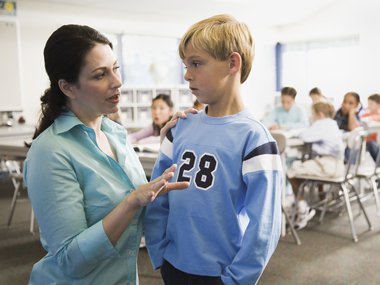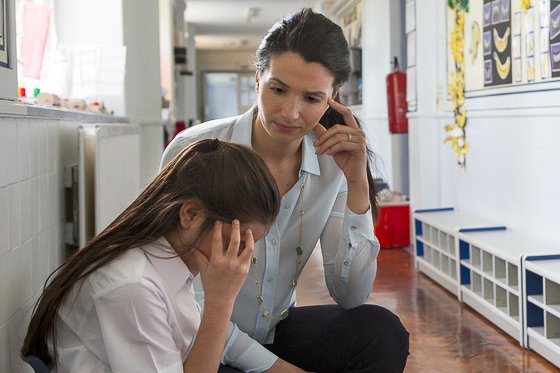10 Assertive Steps in Enforcing Students Discipline

Assertive teachers have strong self-esteem. This is supported by the teacher's habits in making a clear plan, which allows him to respond to the most serious and non-serious incidents with calm attitude. Here are the steps of disciplinary enforcement that use assertiveness.
10 Assertive Steps in Enforcing Discipline

Source: kevinmd.com
Step 1: approach students while doing good things
A supportive and encouraging climate requires attention and positive comments
- Teachers should focus first on children who choose to obey and not those who choose to behave badly.
- Teachers populate well-behaved students in front of the class while ignoring those who do not behave well. The praise given should be specific. For example: "good, I'm glad to see you sit quietly and pay attention to what I explain. Thank you."
- If some children do not return to good behavior, teachers can direct them in a gentle way.
Step 2: Use positive cues
Teachers can use well behaved students as an example / reminder for those who behave badly. This is closely related to step 1, namely:
- The teacher approaches the students when they do good and give praise.
- The teacher redirects the students to appropriate and commendable behavior.
In this case, praise students who behave well near students who behave badly.
Case Example: Noah is playing his pen and not paying attention to the explaining teacher, but Andy sitting next to him notices the teacher's explanation.
- Teacher said, "Andi, thank you for not playing games and paying attention to my explanation. Nice."
- Realizing this, Noah will stop playing with his pen and gaze at the teacher.
- Master then praised his choice with a smile and said, "Thank you Noah."

Source: rd.com
Step 3: Use physical proximity
A teacher's ability to manage his physical closeness with groups and individuals is an important part of classroom management.
Case Example: The teacher noticed that Chandra was not doing his assignment so decided to start walking around the classroom. He then moves slowly toward Chandra while praising the behavior of other students who are working on the task.
- Teacher said, "John, (3 tables away from Chandra) thanks for doing your job quietly."
- Teacher returns to Chandra while continuing to give praise.
- "Bryan, (one table away from Chandra) I'm glad you did your own job very well."
- As soon as Chandra gets back to work, the teacher praises the student.

Source: rd.com
Step 4: Use the question to get the students back in focus
Relaxed-sounding questions can be a powerful way to get students back in focus without attracting much attention.
Case Example: While working on assignment, Silvie is compelled to share her weekend vacation experience. When she tells it, her focus and focus of her friends are distracted.
- Teacher asks questions that return the students' attention gently like: "How is your assignment, do you need help? Silvie, can I check the results of your assignment? "
- Then the teacher leaves the re-focused student to resume her duties in the hope that she will continue to obey: "I'll come back in a minute and check your progress."
Step 5: Repeat the directions personally
Giving a short and personal briefing student followed by giving a few seconds to allow the student to refocus his behavior is very effective. Especially for students who have a bad response to public reprimands.
Case Example: The teacher realizes that David stopped focusing on the assignment.
- Teacher silently approached him and said, "David, I want you to go back to your work. Thank you."
- David probably will not obey immediately. The teacher pulls away and gives him a few seconds to change his attitude.
- When David returns to his work, the teacher returns to him and gives positive support for his improved behavior.

Source: startsingingnowtheblog
Step 6: Acknowledge and redirect
Teachers should not be trapped into argumentative or secondary behavior. Smart teachers use recognition followed by redirection.
Case Example: Desy speaks with Beny and does not do their assignment.
- The teacher approaches them, then says, "Beny, Desy, I hope you guys go back to your work now, thank you."
- Desy replied, "I just asked Beny, what's the lesson after this."
- Teacher responds, "I know you need to know what the next lesson is. You can ask him at the end of this lesson (confession). Now, I hope you get back to work (redirect). Thank you. "(Expecting compliance).
Step 7: Provide a clear reminder of rules
Reminders of personal strict class rules are a very effective and nonconfrontational strategy by calling them "our rules" not "teacher rules."
Case Example: when asking questions to the class, some students raised their hands to answer. However, Olin immediately answered without first raising his hand. The teacher can then remind him with a sentence like. "Olin, remember our class rules for raising our hands if we want to answer questions? I hope you stick with it now. Accept it. "

Source: news.stanford.edu
Step 8: Give a clear choice
Expressing the consequences of unsustainable sustainable choices, expressly restores the student's own control and responsibility center. Just like step 7, it throws away the arbitrary elements that may appear from a teacher.
Case Example: Bryan gets up from his seat to talk back to Mario.
- Teacher approached the student. Calmly and firmly, he expressed the consequences of unsustainable bad behavior (not where to speak).
- Teacher then said, "Bryan, I hope you stay in your chair (declare redirection), if you choose not to do so, you choose to come to me at the end of the lesson (states the consequences). Come back to your seat now. Thanks.
Step 9: Use approved consequences
If students continue to make poor choices, teachers can apply mutually agreed consequences.
Case Example: Mario constantly broke a mutually agreed agreement in class.
- Teacher said, "Mario, you chose to face me at the end of this lesson (apply consequences). Now, go back to your seat. Thank you."
- If the student continues to make poor choices or openly refuses to cooperate, the teacher can repeat steps 8 and 9 calmly.
- Then, the teacher praises when the student is obedient.

Source: universalclass.com
Step 10: Use "Get Out" strategy
If some students continually interrupt the teaching process significantly and / or other students' learning processes, they can be excluded from the classroom using procedures approved by the school. However, please note that this type of punishment is a serious punishment.
- Usually, for a "Get Out" punishment, a child should be given a choice ("Danny, you have chosen to be expelled from the class"). In addition, this step is done if the previous 9 steps can not discipline the student.
- The teacher applies this step calmly and firmly accompanied by a clear message that the "Get Out" punishment is upheld because of the poor choice of the student.
- After the punishment has been completed, the teacher should, following up by speaking to the student and planning better options later.
Generally, if the steps taken by the teacher do not bring the expected results, the students are required to create some kind of "letter of agreement". This letter sometimes becomes a powerful recipe for tackling the problem. Teachers do not need to drop students' self-esteem, but they still have to take responsibility for the choices they have taken.
Source:
- Wahyono. Joko. 2012. Cara Ampuh Merebut Hati Murid. Jakarta: Esensi
My previous post related to education:
- [How Assertive Teachers Uphold Discipline to Their Students?]https://steemit.com/steemiteducation/@herryzal/how-assertive-teachers-uphold-discipline-to-their-students-2017106t20281759z)
- Are You a Teacher? Be an Assertive Teacher
- How to Attract Students' Attention
- The Teachers As A Wonderful Hope For The Students, Is Not A Person To Be Feared
- Teachers' Behavior in Teaching Their Students
- Science is Acquired by Learning While Patience by Practicing
- Developing Self-Expertise in Daily Life
- Why We Have to Dig Up Self-Expertise!
- Keep the Spirit and Always Try to Be Better
An assertive teacher was a creative teacher. In my opinion, when a teacher can makes his students confort in learning, he can communicates personally with his students, thus he is an assertive student
Agreed with you @redrose. We as a teacher have to creat a good communication with our students. Thanks for your supports.
It was very challenging when we are a teacher. We have to be assertive to ourselves and also to our students. We have not to be anger in facing our students, even we have a big problem in our mind. Patient makes us succeed in teaching. Thanks for sharing buddy.
Thanks you so much dear. We have to be patient all day long when we were teaching.
Personally I like to scare the shit out of anyone actng badly. It's important that they associate fear and negative emotions with bad behavior so they won't do it again.
Thanks buddy for your supports. I think we have to choose a right student when we want to act like you said.
Great Post, We really need more quality education training. Keep it up.
Thanks a lot brother. We have to do our best for our next generation
terrific post mas bro...
Thanks bro, I saw your posts were more awesome, good luck.